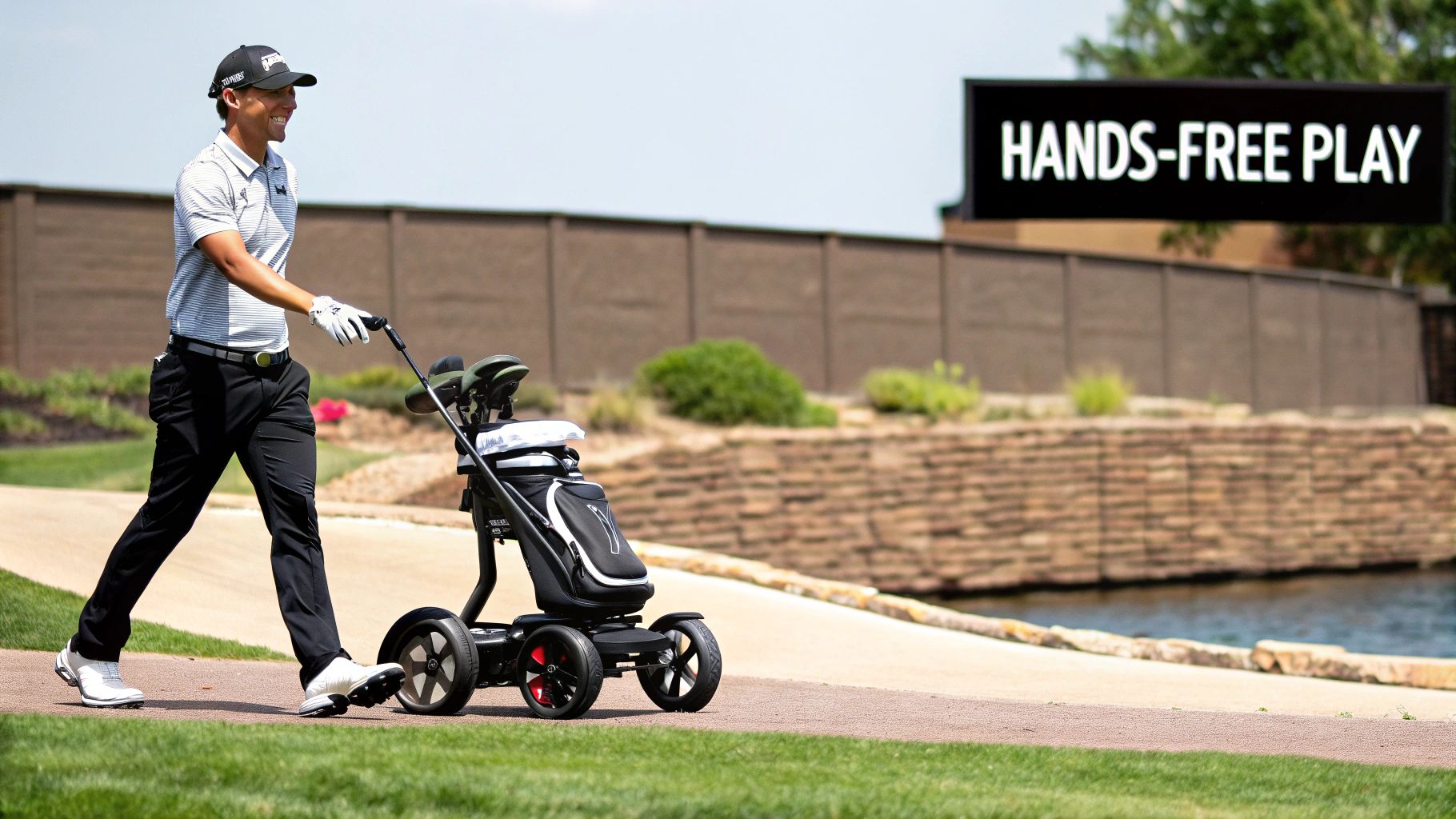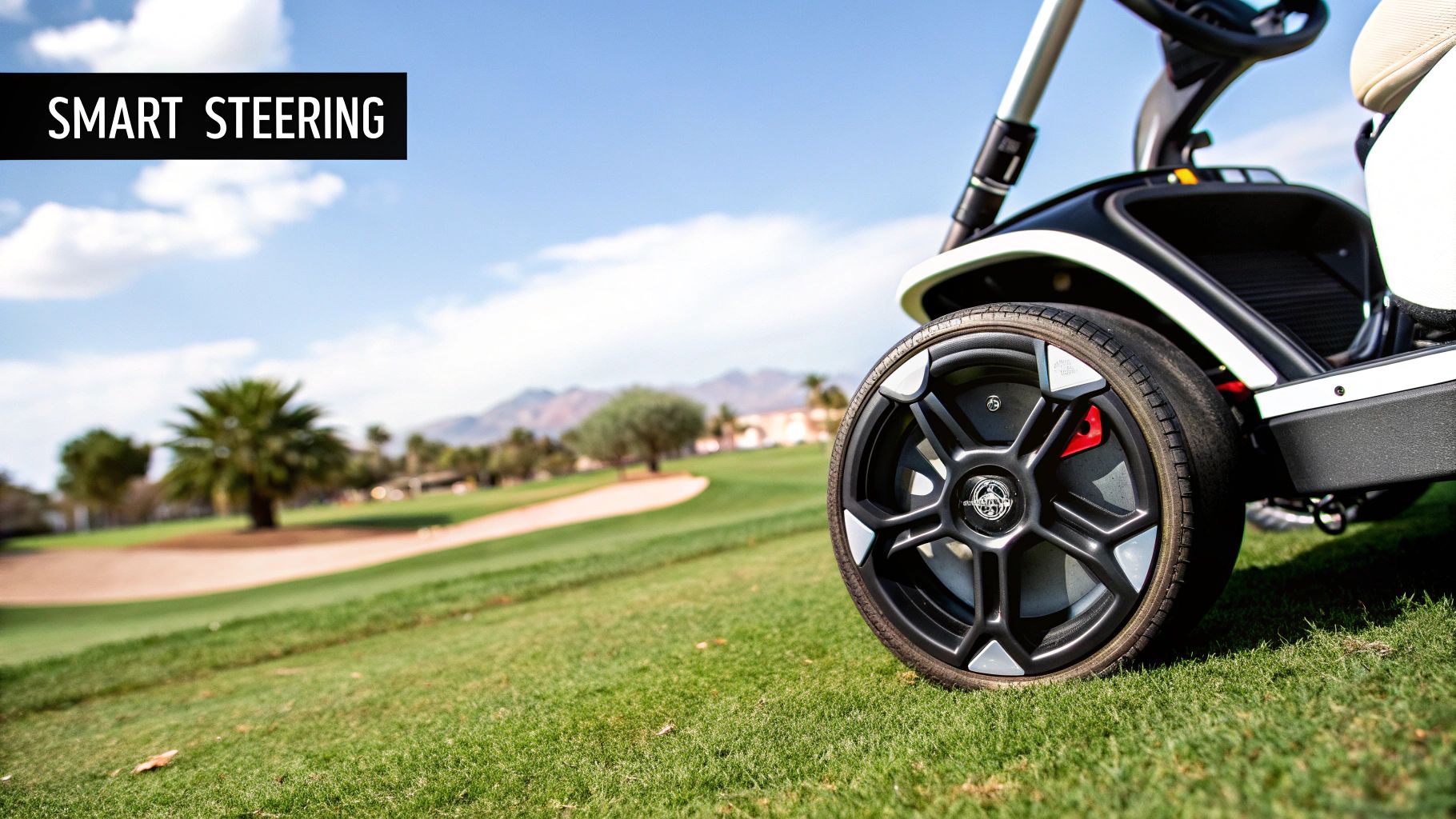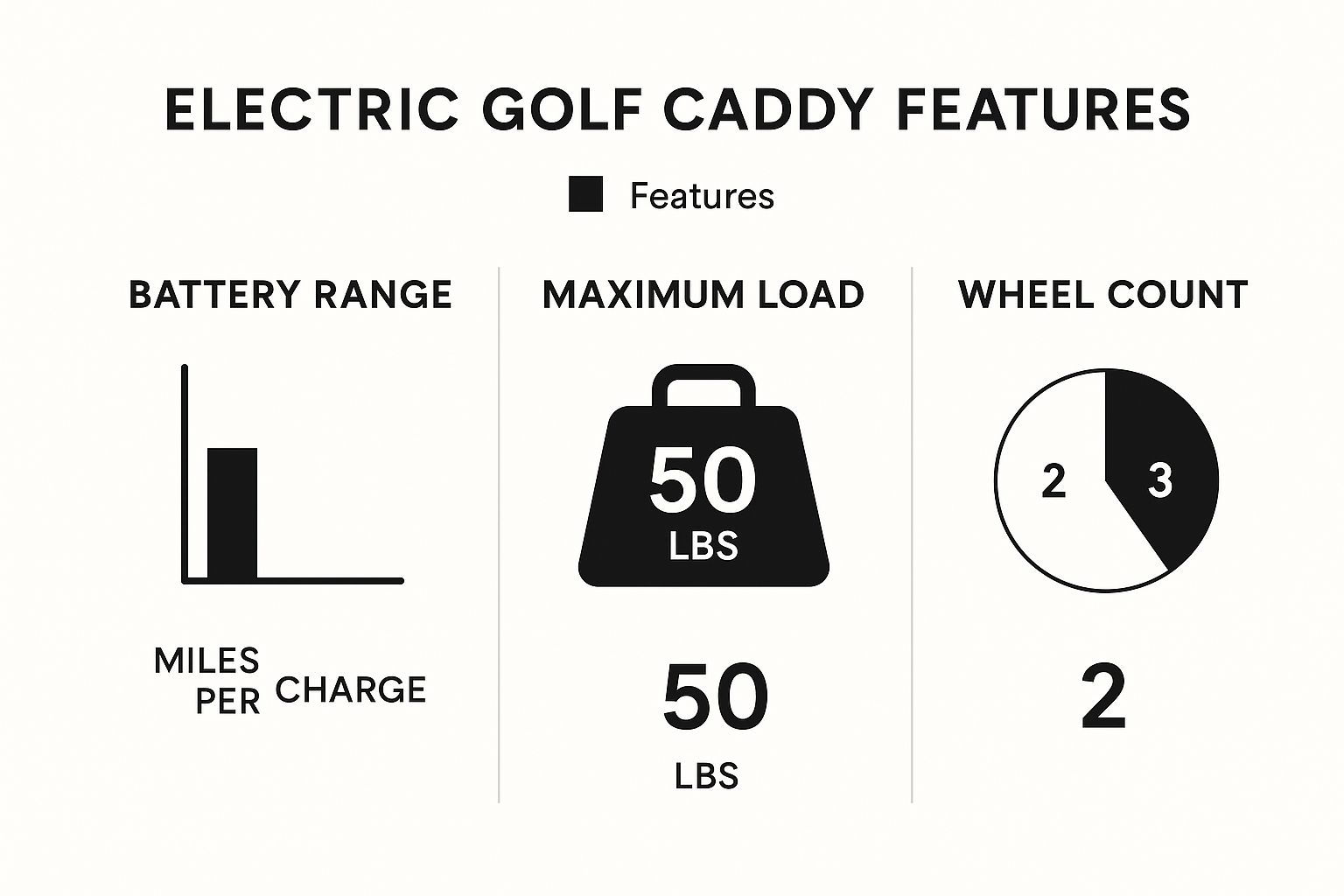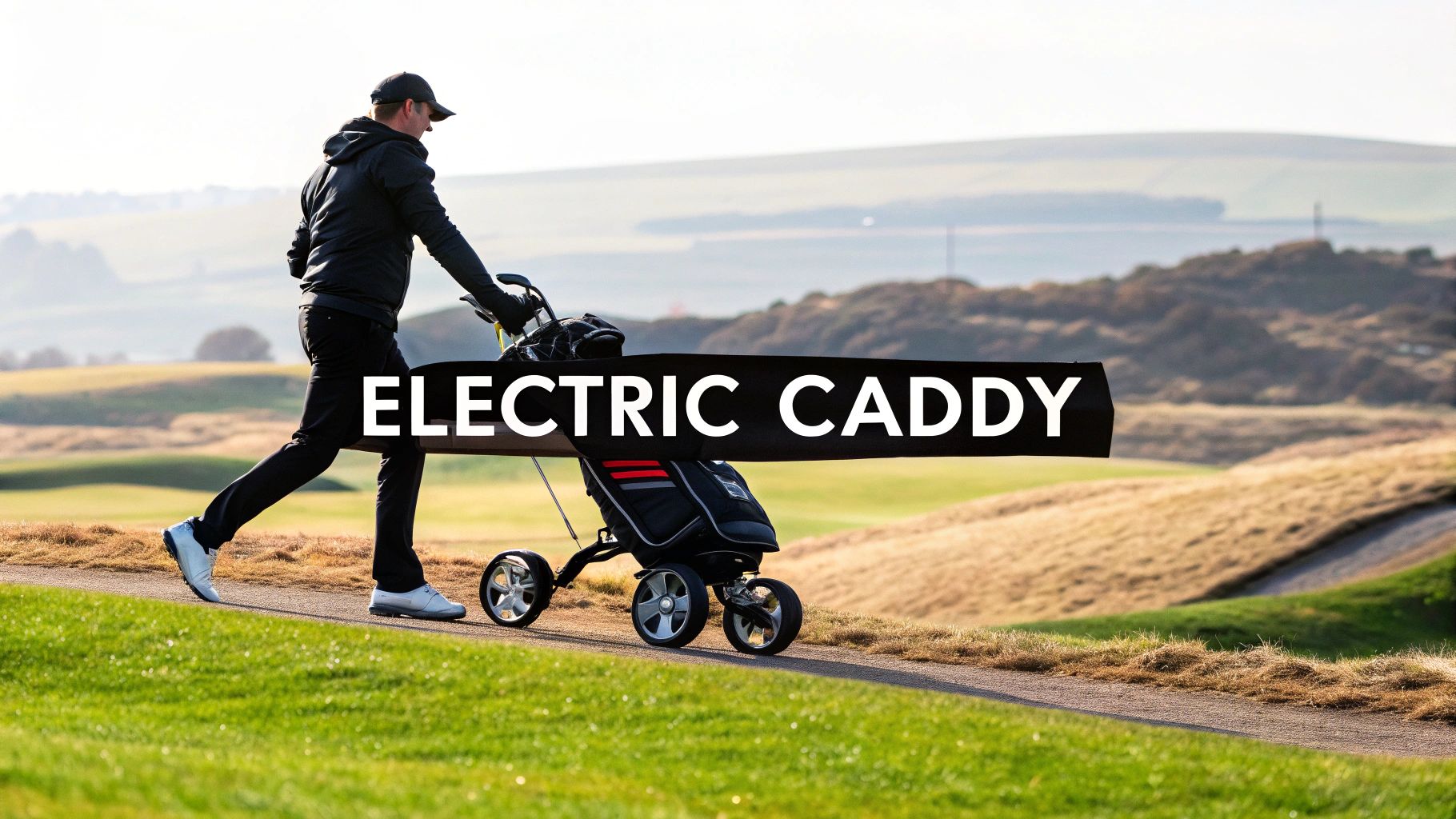Ever wondered what an electric golf caddy actually is? In short, it’s a motorized trolley built specifically to carry your golf bag. This lets you walk the course without the physical drag of hauling your clubs around for 18 holes, saving your energy for the swing.
How an Electric Caddy Transforms Your Golf Game

Picture this: you're walking the fairway on a perfect afternoon, totally dialed in on your next shot. You're not wrestling with a heavy bag or grunting as you push a manual cart up a hill. Instead, a quiet, robotic partner glides right beside you, carrying the load. This isn't some far-off fantasy for the pros; it's exactly what an electric golf caddy brings to your game.
Think of it as the ultimate upgrade—a move from manual labor to smart, effortless automation. By taking the burden of your gear off your shoulders, the caddy frees you up, both physically and mentally, to focus on what really matters: playing better golf.
The Strategic Advantage on the Course
The biggest win with an electric caddy is simple: energy conservation. A typical round of golf has you walking four to five miles. When you're carrying or pushing a 30-pound bag that whole way, it takes a serious toll. By the time you hit the back nine, that physical fatigue often creeps into your game, causing mental mistakes and sloppy swings.
An electric caddy completely changes that dynamic. It's like having a tireless partner that ensures you feel as fresh on the 18th hole as you did on the first tee. That shift has a real, tangible impact on your scorecard.
"By bringing our electric caddies to the junior level, we are helping young athletes conserve energy, play more focused golf, and gain confidence in a competitive environment."
And that's not just for young guns. The same principle applies to every golfer, no matter their age or handicap. Saving energy means staying sharp and making better decisions when the pressure is on.
It's More Than Just a Cart
Beyond just saving your energy, an electric caddy genuinely makes the whole experience of a round of golf better. It’s about being able to enjoy the walk, soak in the scenery, and chat with your buddies without being weighed down. It makes the game healthier and way more enjoyable.
Here’s how it really changes things:
- Reduced Physical Strain: Say goodbye to the repetitive stress on your back, shoulders, and knees from carrying clubs.
- Improved Focus: With your bag taken care of, you can put all your mental energy into shot selection and course strategy.
- Enhanced Enjoyment: It turns what can be a physically demanding trek into a pleasant walk, making the game more accessible and just plain fun.
Understanding How Your Electric Caddy Works

So, how does this thing actually follow you around the course? At its core, an electric golf caddy is a specialized little vehicle designed with one mission: to carry your clubs so you don't have to. Think of it as a team of three components working in perfect harmony: a powerful battery, a quiet motor, and a smart control system.
This entire setup is built on a sturdy but surprisingly lightweight chassis—the caddy's skeleton. This frame provides all the stability needed to tackle uneven fairways and hilly terrain, but it’s also engineered to fold down neatly for easy transport.
The Powerhouse and the Engine
The lifeblood of your electric caddy is its battery. Most modern caddies run on high-capacity lithium-ion batteries, the very same tech that powers your smartphone and even electric cars. This battery is your fuel tank, storing all the juice you need for a full round, and often enough for two.
From there, the power flows to the motor. Tucked away near the axle, these compact motors are the engine of the operation, turning that electrical energy into forward motion. They’re designed for high torque, which is just a fancy way of saying they have the muscle to climb steep hills without breaking a sweat. And, crucially, they're engineered to be almost silent, so nothing will distract you from your game.
Just as an electric car delivers instant torque for quick acceleration, an electric golf caddy provides immediate power to its wheels, allowing it to conquer slopes and tough terrain with a stability that manual push carts simply can't match.
The Brains of the Operation
If the battery is the heart and the motor is the muscle, the control system is definitely the brain. This is what translates your commands into action, and the "smarts" can range from super simple to seriously advanced depending on the model you choose. Understanding these control types is key when you’re figuring out how an electric push cart works.
Let's break down the most common setups.
Control System Types
-
Handlebar Controls: This is the most straightforward system. You'll find speed dials and buttons right on the handle, letting you set a comfortable walking pace that the caddy will maintain. You still steer it like a traditional push cart, but without any of the effort.
-
Remote Control: This is where things get fun. A small handheld remote gives you the freedom to steer the caddy from a distance. You can send it ahead to the next tee box while you mark your scorecard or guide it around a bunker from across the fairway.
-
Follow Technology: Welcome to the future. This is the most advanced option out there, using sensors or even AI visual tracking to have the caddy automatically follow you as you walk. It maintains a perfect distance, creating a truly hands-free experience. It’s less of a caddy and more of a personal golf robot.
Each piece of the puzzle—from the rugged chassis and long-lasting battery to the intelligent control system—comes together to create a smooth, powerful, and responsive machine. This perfect synergy is what makes an electric golf caddy an absolute game-changer for the modern golfer.
The Real-World Benefits of Walking the Course Freely

Putting the technical specs aside, the real magic of an electric golf caddy is how it completely changes your day on the course. The difference is immediate, affecting everything from your physical well-being to your mental game. It’s not just about skipping the heavy lifting—it’s about getting your energy and focus back where they belong.
Think about it: playing a full 18 holes without that nagging back and shoulder ache from hauling a 30-pound bag for miles. This isn't just about comfort; it's a huge performance issue. Physical fatigue is a swing-killer, especially as you get deeper into the round.
Preserve Your Body and Your Swing
An electric caddy takes that physical burden completely off your shoulders. By letting a quiet motor do the work, you're shielding your body from the repetitive strain that leads to soreness or even long-term injury. You still get all the health benefits of walking the course, just without the painful side effects.
This saved energy really pays off on the back nine. Instead of feeling drained and just trying to make it to the clubhouse, you feel fresh. That physical wellness translates directly into better golf. You can hold your posture, keep your clubhead speed consistent, and hit shots with precision from the first tee to the last putt.
By eliminating the physical fatigue of carrying or pushing a heavy bag, golfers can maintain a higher level of mental acuity throughout their round. This saved energy directly contributes to sharper decision-making, better course management, and ultimately, lower scores.
The numbers back this up. In the wider golf trolley market, electric models captured a massive 43.2% market share in 2024, showing a clear shift toward powered carts. The market is only growing, with projections hitting USD 247.7 million by 2034.
Sharpen Your Mental Focus
The perks aren't just physical. When you’re not constantly thinking about the weight on your back or grinding to push a cart up a steep hill, your mind is free to lock in on what actually matters: your next shot. You suddenly have more mental bandwidth for plotting your strategy, reading the greens, and visualizing a great outcome.
This sharpened focus is one of the biggest, yet most underrated, advantages of an electric caddy. It helps you stay in the zone for the entire round, preventing the mental slip-ups that lead to bogeys and doubles. For a deeper dive, check out our guide on the top 5 benefits of electric push carts for golfers.
On top of all that, modern caddies add a layer of practical convenience that just makes the game smoother. Most of them come equipped with thoughtful features like:
- Integrated Holders: You’ll find dedicated spots for your drink, scorecard, phone, and GPS, keeping everything organized and right at your fingertips.
- Umbrella Mounts: A sturdy holder keeps you and your gear dry during a pop-up shower, leaving your hands free to manage your game.
- Effortless Navigation: With remote controls and automatic braking, getting around hills and tricky terrain becomes completely stress-free.
Choosing the Right Features for Your Game
Picking the right electric golf caddy feels a lot like choosing the perfect club for a tricky shot—it’s all about matching the gear to your game and the course you play most often. The market is packed with options, from simple, no-fuss workhorses to high-tech models with features that would have seemed like science fiction a decade ago.
The key to making a smart investment is understanding what really matters under the hood.
It all starts with the caddy’s powerhouse: the battery. This single component determines how long your caddy runs and how much it weighs. Thankfully, most modern caddies use lithium-ion batteries. They're lighter, charge way faster, and last much longer than the clunky lead-acid batteries of the past. A good lithium battery should easily get you through 18 holes, with premium models often lasting a full 36 holes on one charge.
Next up is the motor. Think of it as the caddy’s muscle, responsible for powering up steep hills without breaking a sweat. If your home course is hilly, a powerful motor is a must-have. Don't even think about skimping here. A weaker motor might save a few bucks upfront, but you'll regret it on the first big incline.
Core Components and Must-Have Functions
Beyond the battery and motor, you need to look at the caddy's frame and overall stability. A well-built caddy should be made from something lightweight but tough, like aluminum or carbon fiber. Most importantly, it has to fold down into a compact size for easy transport. The last thing you want is to be wrestling with a complicated piece of equipment in the parking lot.
The image below breaks down a few key specs you'll want to compare when you're shopping around.

As you can see, things like battery range and wheel configuration make a real difference out on the course.
Another feature that’s an absolute game-changer is downhill braking. Caddies without it can easily get away from you on steep declines, which is both annoying and dangerous.
An automatic braking system, often called Downhill Speed Control (DSC), uses the motor to maintain a steady, controlled pace when you’re heading downhill. It prevents runaways and saves your back and knees from having to physically hold the caddy back.
Advanced Tech for the Modern Golfer
Once you’ve got the essentials covered, you can start looking at the fun stuff—the advanced features that turn a convenient tool into a truly hands-off experience.
To help you decide what’s worth the extra investment, here’s a quick comparison of the most common features, from the must-haves to the high-tech luxuries.
Electric Golf Caddy Feature Comparison
This table compares essential and advanced features to help you decide which are most important for your golfing style and budget.
| Feature | What It Does | Best For | Consideration |
|---|---|---|---|
| Lithium-Ion Battery | Powers the caddy. Lighter, faster charging, and longer lifespan than older battery types. | All golfers. This is the modern standard for good reason. | Check the advertised hole range (18 vs. 36) to match your playing habits. |
| Powerful Motor | Provides the torque needed to climb hills without slowing down or struggling. | Golfers who play on hilly or undulating courses. | A less powerful motor is fine for flat courses but will struggle on inclines. |
| Downhill Speed Control | Automatically maintains a steady speed when going downhill, preventing runaways. | Golfers on hilly courses. Essential for safety and control. | A critical safety feature that's worth paying a little extra for. |
| Remote Control | A handheld remote allows you to steer the caddy from a distance (up to 50-100 yards). | Golfers who want freedom to walk separately from their caddy. | Requires a bit of practice to master, but offers incredible convenience. |
| Follow Mode | Uses sensors to automatically follow you as you walk, keeping a set distance. | Golfers who want the ultimate hands-free experience. | This is a premium feature, so expect a significant jump in price. |
| Obstacle Avoidance | High-end sensors detect and navigate around obstacles like trees or sand traps. | Tech enthusiasts looking for the most autonomous caddy available. | The newest and most expensive feature on the market; not essential for most. |
Ultimately, choosing the right electric golf caddy comes down to balancing these features with your budget. For most golfers, a reliable battery, a strong motor, and a stable, easy-to-fold frame are the non-negotiables. From there, you can decide if the convenience of a remote or the futuristic appeal of follow mode is worth the upgrade for your game.
Simple Maintenance for Peak Performance
Think of your electric golf caddy as a key piece of equipment in your bag. Just like you'd wipe down your clubs after a round, a little routine care will keep your caddy performing at its best, ensuring it's always reliable and extending its life for seasons to come. The best part? It's surprisingly simple and doesn't require a garage full of tools.
Your maintenance journey starts the moment you unbox it. The single most important first step is that initial battery charge. Always follow the manufacturer’s instructions, but the golden rule is to give it a full, uninterrupted charge before its maiden voyage. This helps condition the battery for a long, healthy life. While it's powering up, take a minute to pair the remote control if your caddy has one—it's usually a quick process that takes less than 60 seconds.
Your Regular Maintenance Checklist
After that initial setup, a quick post-round check-up is all it takes to keep your electric caddy running like new. This simple, two-minute routine can prevent bigger headaches down the road.
-
Cleanliness is Key: Wipe down the frame and wheels after every round. Grass, sand, and mud can build up, putting extra strain on the motor and causing unnecessary wear on moving parts. A damp cloth for the frame and a stiff brush for the wheels will do the trick.
-
Check the Connections: Give any visible cables and connection points a quick look. You want to make sure everything is secure and free of debris. A loose connection can cause frustrating power issues mid-round.
-
Tire and Axle Inspection: Give the wheels a quick spin. They should rotate freely without any wobbling or grinding sounds. Be sure to clear out any tangled grass or string from around the axle so the motor can operate at peak efficiency.
The single most important component to maintain is the battery. Proper care is the difference between a battery that lasts for hundreds of rounds and one that fails after just a couple of seasons. It’s the heart of your caddy.
Maximizing Battery Lifespan
The battery is the powerhouse of your electric golf caddy, and its health is everything. To get the most out of it, charge it after every single use—even if you only played nine holes. Lithium-ion batteries are happiest when they aren't fully drained.
It's also smart to store the battery in a cool, dry place away from extreme temperatures, since both heat and cold can degrade its capacity over time. For a deeper dive, you can learn all about proper golf cart battery maintenance in our detailed guide.
By following these straightforward steps, you’re not just maintaining a piece of equipment; you're protecting your investment and making sure your caddy is always ready to roll when you are.
Still Have a Few Questions?
Thinking about an electric caddy is a big step, and it’s natural to have a few questions before you commit. To make sure you're completely confident, here are some straight-up answers to the most common things golfers ask.
How Long Does an Electric Caddy Battery Last on a Single Charge?
Most modern electric caddies running on lithium-ion batteries will easily get you through a full 18 to 36 holes on a single charge. Of course, the exact mileage you get will depend on your model, how heavy your bag is, and the course itself.
A super hilly course is going to drain the battery faster than a flat one, that’s just physics. The best habit to get into? Just top off the battery before every round. That way, you'll never have to worry about running out of juice on the back nine.
Are Electric Golf Caddies a Pain to Transport and Store?
Not at all. In fact, most electric caddies are designed specifically with portability in mind. They almost always feature lightweight frames and simple folding mechanisms that let them collapse down to a surprisingly compact size.
This makes them a breeze to pop into your trunk or tuck away in the garage. Many even have quick-release wheels, letting you make them even smaller for tight spots like a club locker.
The whole point of a modern electric caddy is to make your life easier, not give you another piece of complicated gear to wrestle with. Portability is just as critical as its performance on the course, ensuring the caddy simplifies every part of your golf day—from the car to the 18th green.
Can I Use an Electric Golf Caddy in the Rain?
Absolutely. Any quality electric caddy is built to be water-resistant, so you can keep playing through typical rainy conditions without worry. The important stuff—like the motor, battery, and controls—is sealed up tight to keep moisture out.
Now, they aren't fully waterproof, so you definitely shouldn't try to drive it into a water hazard. But for a wet day on the links, you're good to go. It's always a good idea to give it a quick wipe-down with a dry towel after a soggy round.
What Is the Difference Between Remote Control and Follow Modes?
This is a great question, as it gets into the two main ways you can operate these caddies.
A remote-controlled caddy is exactly what it sounds like. You use a handheld remote to steer it forward, backward, left, and right. This gives you direct, precise control over where your caddy goes at all times.
Follow mode is the next level of hands-free tech. The caddy uses sensors to lock onto you and automatically follow you down the fairway, keeping a consistent distance without you touching a single button.
Ready to make walking the course effortless? The Caddie Wheel converts your existing push cart into a powerful electric caddy in minutes. Explore the Caddie Wheel and upgrade your game today!


Share:
MGI Electric Golf Cart Comparison Guide
Swing Pain-Free Golf and Back Pain Solutions